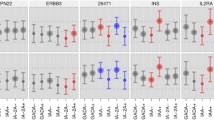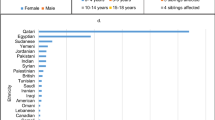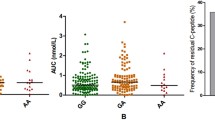Abstract
Aims
T2D and T1D are phenotypically heterogeneous. This study aims to reveal the relationship between the common SLC30A8 rs13266634 variant and subgroups of T2D and T1D and their clinical characteristics.
Methods
We included 3158 OGTT-based healthy controls, unrelated 1754 T2D, and 1675 autoantibody-positive T1D individuals. The associations between rs13266634 and subtypes of T2D, T1D, autoantibody status and glycemic-related quantitative traits were performed by binary logistic regression analysis under the additive model and multiple linear regression with appropriate adjustment.
Results
We found that the T allele of rs13266634 was protectively associated with lean (OR = 0.810, P = 6.91E–04) but not obese T2D with considerable heterogeneity (P = 0.018). This allele also conferred significant protection with T1D of single (OR = 0.847, P = 9.76E–03), but not multi autoantibodies with substantial heterogeneity (P = 0.005). This variant significantly affected OGTT-related insulin release in lean (P = 2.66E–03, 3.88E–03 for CIR and DI, respectively) but not obese healthy individuals. Furthermore, rs13266634 T allele correlated with the risk of ZnT8A (OR = 1.440, P = 3.31E–05) and IA-2A (OR = 1.219, P = 1.32E–03) positivity, with more effect size in children/adolescents compared with adult-onset T1D subtypes.
Conclusions
These suggested that the SLC30A8 rs13266634 variant might be put into genetic risk scores to assess the risk of the subtypes of T1D and T2D and their related clinical features.
Similar content being viewed by others
References
Chimienti F, Devergnas S, Favier A, Seve M (2004) Identification and cloning of a beta-cell-specific zinc transporter, ZnT-8, localized into insulin secretory granules. Diabetes 53:2330–2337
Sladek R, Rocheleau G, Rung J et al (2007) A genome-wide association study identifies novel risk loci for type 2 diabetes. Nature 445:881–885
Spracklen CN, Horikoshi M, Kim YJ et al (2020) Identification of type 2 diabetes loci in 433,540 East Asian individuals. Nature 582:240–245
Vujkovic M, Keaton JM, Lynch JA et al (2020) Discovery of 318 new risk loci for type 2 diabetes and related vascular outcomes among 1.4 million participants in a multi-ancestry meta-analysis. Nat Genet 52:680–691
Stancáková A, Kuulasmaa T, Paananen J et al (2009) Association of 18 confirmed susceptibility loci for type 2 diabetes with indices of insulin release, proinsulin conversion, and insulin sensitivity in 5,327 nondiabetic Finnish men. Diabetes 58:2129–2136
’t Hart LM, Simonis-Bik AM, Nijpels G et al (2010) Combined risk allele score of eight type 2 diabetes genes is associated with reduced first-phase glucose-stimulated insulin secretion during hyperglycemic clamps. Diabetes 59:287–292
Walford GA, Green T, Neale B et al (2012) Common genetic variants differentially influence the transition from clinically defined states of fasting glucose metabolism. Diabetologia 55:331–339
**ang J, Li XY, Xu M et al (2008) Zinc transporter-8 gene (SLC30A8) is associated with type 2 diabetes in Chinese. J Clin Endocrinol Metab 93:4107–4112
Haupt A, Guthoff M, Schäfer SA et al (2009) The inhibitory effect of recent type 2 diabetes risk loci on insulin secretion is modulated by insulin sensitivity. J Clin Endocrinol Metab 94(5):1775–1780
Qu HQ, Grant SF, Bradfield JP et al (2008) Association analysis of type 2 diabetes Loci in type 1 diabetes. Diabetes 57:1983–1986
Raj SM, Howson JM, Walker NM et al (2009) No association of multiple type 2 diabetes loci with type 1 diabetes. Diabetologia 52:2109–2116
Xu K, Zha M, Wu X et al (2011) Association between rs13266634 C/T polymorphisms of solute carrier family 30 member 8 (SLC30A8) and type 2 diabetes, impaired glucose tolerance, type 1 diabetes–a meta-analysis. Diabetes Res Clin Pract 91:195–202
Howson JM, Krause S, Stevens H et al (2012) Genetic association of zinc transporter 8 (ZnT8) autoantibodies in type 1 diabetes cases. Diabetologia 55:1978–1984
Zhu M, Xu K, Chen Y et al (2019) Identification of Novel T1D Risk Loci and Their Association With Age and Islet Function at Diagnosis in Autoantibody-Positive T1D Individuals: Based on a Two-Stage Genome-Wide Association Study. Diabetes Care 42:1414–1421
Perry JR, Voight BF, Yengo L et al (2012) Stratifying type 2 diabetes cases by BMI identifies genetic risk variants in LAMA1 and enrichment for risk variants in lean compared to obese cases. PLoS Genet 8:e1002741
Liley J, Todd JA, Wallace C (2017) A method for identifying genetic heterogeneity within phenotypically defined disease subgroups. Nat Genet 49:310–316
Ning G; Reaction Study Group (2012) Risk Evaluation of cAncers in Chinese diabeTic Individuals: a lONgitudinal (REACTION) study. J Diabetes 4:172–173
Adler A, Bennett P, Colagiuri Chair S, et al (2021) Reprint of: classification of diabetes mellitus. Diabetes Res Clin Pract. 108972.
Gu Y, **ao L, Gu W et al (2018) Rs2227982 and rs2227981 in PDCD1 gene are functional SNPs associated with T1D risk in East Asian. Acta Diabetol 55(8):813–819
Pan XF, Wang L, Pan A (2021) Epidemiology and determinants of obesity in China. Lancet Diabetes Endocrinol 9(6):373–392
Cauchi S, Nead KT, Choquet H et al (2008) The genetic susceptibility to type 2 diabetes may be modulated by obesity status: implications for association studies. BMC Med Genet 9:45
Timpson NJ, Lindgren CM, Weedon MN et al (2009) Adiposity-related heterogeneity in patterns of type 2 diabetes susceptibility observed in genome-wide association data. Diabetes 58:505–510
Dwivedi OP, Lehtovirta M, Hastoy B et al (2019) Loss of ZnT8 function protects against diabetes by enhanced insulin secretion. Nat Genet 51:1596–1606
Kirchhoff K, Machicao F, Haupt A et al (2008) Polymorphisms in the TCF7L2, CDKAL1 and SLC30A8 genes are associated with impaired proinsulin conversion. Diabetologia 51:597–601
Iwata M, Maeda S, Kamura Y et al (2012) Genetic risk score constructed using 14 susceptibility alleles for type 2 diabetes is associated with the early onset of diabetes and may predict the future requirement of insulin injections among Japanese individuals. Diabetes Care 35:1763–1770
Choi CHJ, Cohen P (2017) How does obesity lead to insulin resistance? Elife 6:e33298
Andersen ML, Vaziri-Sani F, Delli A et al (2012) Association between autoantibodies to the Arginine variant of the Zinc transporter 8 (ZnT8) and stimulated C-peptide levels in Danish children and adolescents with newly diagnosed type 1 diabetes. Pediatr Diabetes 13:454–462
Nielsen LB, Vaziri-Sani F, Pörksen S et al (2011) Relationship between ZnT8Ab, the SLC30A8 gene and disease progression in children with newly diagnosed type 1 diabetes. Autoimmunity 44:616–623
Aylward A, Chiou J, Okino ML et al (2018) (2018) Shared genetic risk contributes to type 1 and type 2 diabetes etiology. Hum Mol Genet. https://doi.org/10.1093/hmg/ddy314
Redondo MJ, Geyer S, Steck AK et al (2018) TCF7L2 genetic variants contribute to phenotypic heterogeneity of type 1 diabetes. Diabetes Care 41:311–317
Syring KE, Bosma KJ, Goleva SB et al (2020) Potential positive and negative consequences of ZnT8 inhibition. J Endocrinol 246:189–205
Cerolsaletti K, Hao W, Greenbaum CJ (2019) Genetics Coming of Age in Type 1 Diabetes. Diabetes Care 42:189–191
Wenzlau JM, Liu Y, Yu L et al (2008) A common nonsynonymous single nucleotide polymorphism in the SLC30A8 gene determines ZnT8 autoantibody specificity in type 1 diabetes. Diabetes 57:2693–2697
Long AE, George G, Williams CL (2021) Persistence of Islet Autoantibodies after diagnosis in Type 1 Diabetes. Diabet Med 6:e14712
Delli AJ, Vaziri-Sani F, Lindblad B et al (2012) Zinc transporter 8 autoantibodies and their association with SLC30A8 and HLA-DQ genes differ between immigrant and Swedish patients with newly diagnosed type 1 diabetes in the better diabetes diagnosis study. Diabetes 61:2556–2564
Giacconi R, Malavolta M, Chiodi L et al (2018) ZnT8 Arg325Trp polymorphism influences zinc transporter expression and cytokine production in PBMCs from patients with diabetes. Diabetes Res Clin Pract 144:102–110
Li L, Bai S, Sheline CT (2017) hZnT8 (Slc30a8) transgenic mice that overexpress the R325W polymorph have reduced Islet Zn2+ and proinsulin levels, increased glucose tolerance after a high-fat diet, and altered levels of pancreatic zinc binding proteins. Diabetes 66:551–559
Merriman C, Huang Q, Rutter GA, Fu D (2016) Lipid-tuned zinc transport activity of human ZNT8 protein correlates with risk for type-2 diabetes. J Biol Chem 291:26950–26957
Xu J, Wijesekara N, Regeenes R et al (2021) Pancreatic β cell-selective zinc transporter 8 insufficiency accelerates diabetes associated with islet amyloidosis. JCI Insight 6:143037
Acknowledgements
This study was supported by grants from the National Natural Science Foundation of China (81670715 and 82070803), Jiangsu Province Youth Medical Talents Project (QNRC2016584), the Natural Science Foundation of Jiangsu Province (BK2012486), Jiangsu Government Scholarship for Overseas Studies (JS-2013-260), and the Priority Academic Program Development of Jiangsu Higher Education Institutions (PAPD).
Author information
Authors and Affiliations
Contributions
Kuanfeng Xu directed the study design, performed statistical analysis and interpretation of data, and drafted the initial manuscript. Hui Lv, Jie Zhang, and Yunqiang He were responsible for the analysis and interpretation of data. Hao Dai and Shuai Zheng contributed to the collection and selection of samples. Heng Chen, Min Shen, Yu Qian, Hemin Jiang contributed to Laboratory measurements. Qi Fu and Tao Yang gave a critical revision of the manuscript. All the co-authors gave the final approval of the version.
Corresponding authors
Ethics declarations
Conflict of interest
The authors declare that there is no duality of interest associated with this manuscript.
Human and Animal Rights
This study was a study with human samples, which was approved by the Ethics Committee from the First Affiliated Hospital of Nan**g Medical University and conducted in accordance with the ethical standards laid down in the 1964 Declaration of Helsinki and its later amendments.
Informed consent
We also stated that that all persons gave their informed consent prior to their inclusion in the study.
Additional information
Managed by Massimo Porta.
Publisher's Note
Springer Nature remains neutral with regard to jurisdictional claims in published maps and institutional affiliations.
Supplementary Information
Below is the link to the electronic supplementary material.
Rights and permissions
About this article
Cite this article
Xu, K., Lv, H., Zhang, J. et al. The common rs13266634 C > T variant in SLC30A8 contributes to the heterogeneity of phenotype and clinical features of both type 1 and type 2 diabetic subtypes. Acta Diabetol 59, 545–552 (2022). https://doi.org/10.1007/s00592-021-01831-6
Received:
Accepted:
Published:
Issue Date:
DOI: https://doi.org/10.1007/s00592-021-01831-6




